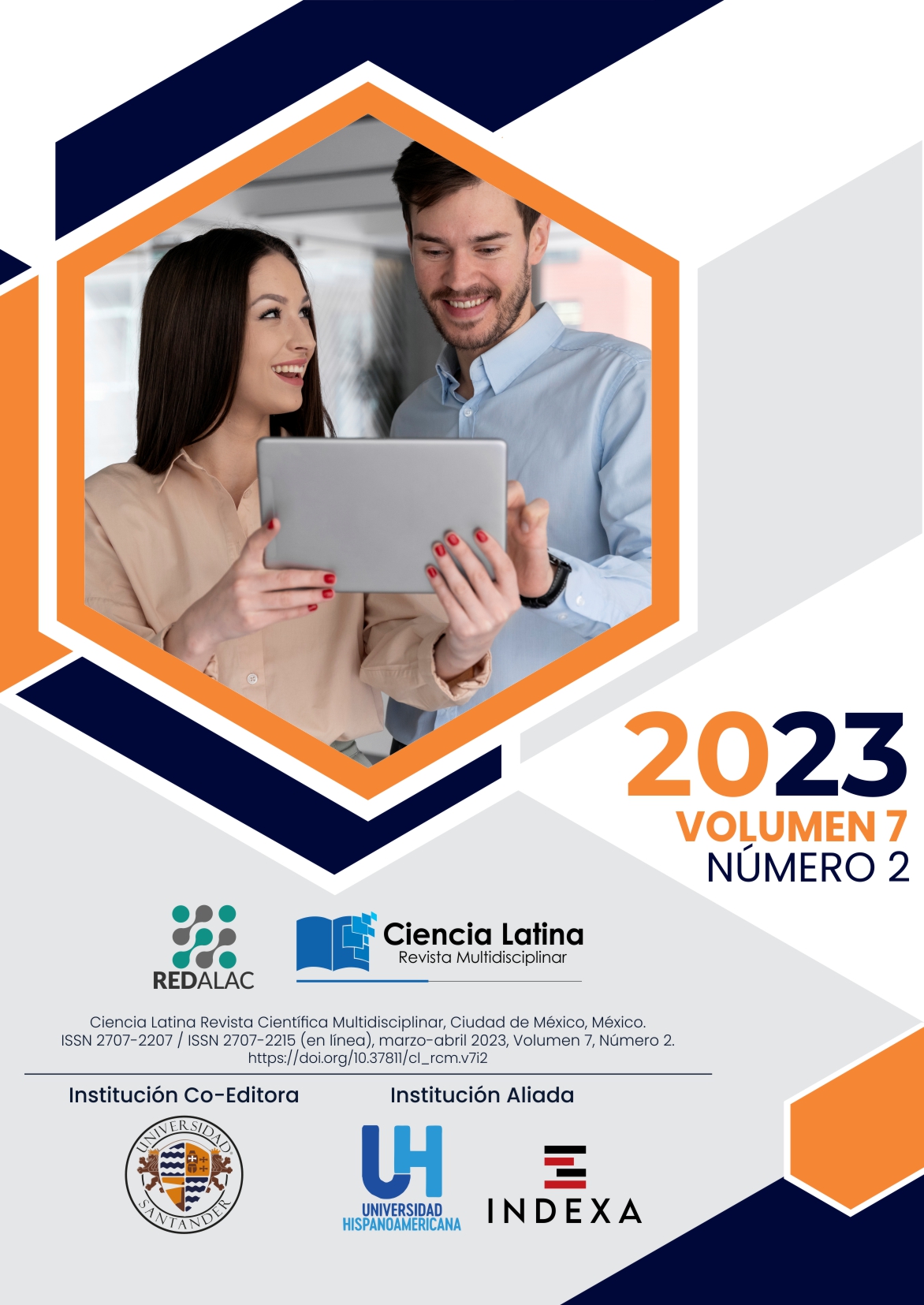Revisión bibliográfica de los tipos de Ergonomía estudiadas en las publicaciones científicas localizadas en la Web of Science, 2019-2022
Resumen
El objetivo de la investigación es llevar a cabo una revisión bibliográfica de los tipos de Ergonomía estudiadas en las publicaciones científicas localizadas en la Web of Science, 2019-2022. Se optó por un enfoque cualitativo con complemento de lo cuantitativo, no experimental, transaccional y descriptivo. Se aplicó el muestreo intencional realizando la búsqueda con dos palabras clave: egonomics y workplace en Web of Science (WOS), enero de 2023. Los criterios de inclusión fueron: publicaciones en journals, acceso abierto, inglés y entre 2019-2022. Los criterios de exclusión fueron: acceso varios (Gold, Gold-Hybrid, Free to Read, Green Published, Green Accepted y Green Submitted), otros idiomas que no sea el inglés, artículos de revisión, resúmenes para conferencias y editorial. Se encontró un total de 77 artículos en la búsqueda y 8 fueron excluídos por no concordancia con el tema. Finalmente, 69 publicaciones sobre la Ergonomía en el lugar de trabajo han sido revisadas y el instrumento de recolección de datos estuvo constituido en 6 ítems (año de publicación, autor/es, título, tipos de ergonomía, revista y DOI). Los resultados más relevantes fueron: existe una mayor concentración de publicaciones en el año 2019 (28%); en las revistas Applied Ergonomics (29%) y Ergonomics (25%) y; la ergonomia Física (55%) es la más estudiada. Se concluye que los factores de riesgo ergonómicos ambientales, físicos, organizacionales y cognitivos de trabajo para cada tipo de trabajo deben tenerse en cuenta sistemáticamente mediante la evaluación regular de los empleados. Un entorno adecuado y amable reduce el impacto negativo sobre la salud del trabajador.
Descargas
Citas
Abdollahpour, N., & Helali, F. (2022). Implementing Practical Ergonomics Knowledge
Transfer Using Ergonomic Checkpoints to Support the Participatory Ergonomics Process in an Industrially Developing Country. IISE Transactions on Occupational Ergonomics & Human Factors, 10(2), 59-70. http://dx.doi.org/10.1080/24725838.2022.2054880
Agila-Palacios, Enmanuel, Colunga-Rodríguez, Cecilia, González-Muñoz, Elvia, &
Delgado-García, Diemen. (2014). Síntomas Músculo-Esqueléticos en Trabajadores Operativos del Área de Mantenimiento de una Empresa Petrolera Ecuatoriana. Ciencia & trabajo, 16(51), 198-205.
https://dx.doi.org/10.4067/S0718-24492014000300012
Antosz, P., Rembiasz, T., & Verhagen, H. (2020). Employee shirking and overworking:
modelling the unintended consequences of work organization. Ergonomics, 63(8), 997-1009. https://doi.org/10.1080/00140139.2020.1744710
Asociación Internacional de Ergonomía (2022). ¿Qué es la ergonomía?
http://www.ergonomos.es/ergonomia.php
Baudendistel, S. T., Grindstaff, T. L., Rosen, A. B., & Yentes, J. M. (2020). Bimanual load
carriage alters sway patterns and step width. Applied Ergonomics, 84. https://doi.org/10.1016/j.apergo.2019.103030
Bergsten, E. L., Haapakangas, A., Larsson, J., Jahncke, H., & Hallman, D. M. (2021).
Effects of relocation to activity-based workplaces on perceived productivity: Importance of change-oriented leadership. Applied Ergonomics, 93.
https://doi.org/10.1016/j.apergo.2020.103348
Berlin, C., Bligard, L. O., Chafi, M. B., & Eriksson, S. (2022). Development of a
stakeholder identification and analysis method for human factors integration in work system design interventions - Change Agent Infrastructure. Human Factors and Ergonomics in Manufacturing & Service Industries, 32(1), 151-170. https://doi.org/10.1002/hfm.20910
Bergefurt, L., Appel-Meulenbroek, R., Maris, C., Arentze, T., Weijs-Perree, M., & de Kort,
Y. (2022). The influence of distractions of the home-work environment on mental health during the COVID-19 pandemic. Ergonomics. https://doi.org/10.1080/00140139.2022.2053590
Beschorner, K. E., Siegel, J. L., Hemler, S. L., Sundaram, V. H., Chanda, A., Iraqi, A.,
Haight, J. M., & Redfern, M. S. (2020). An observational ergonomic tool for assessing the worn condition of slip-resistant shoes. Applied Ergonomics, 88. https://doi.org/10.1016/j.apergo.2020.103140
Bodin, J., Garlantezec, R., Costet, N., Descatha, A., Viel, J. F., & Roquelaure, Y. (2020).
Shoulder pain among male industrial workers: Validation of a conceptual model in two independent French working populations. Applied Ergonomics, 85. https://doi.org/10.1016/j.apergo.2020.103075
Bortolini, R., & Forcada, N. (2021) Regular and temporary occupants’ perceptions of
satisfaction in tertiary education buildings, Ergonomics, 64:7, 926-942, https://doi.org/10.1080/00140139.2021.1882706
Chanda, A; Reuter, A; Beschorner, KE. (2019). Vinyl Composite Tile Surrogate for
Mechanical Slip Testing. IISE Transactions on Occupational Ergonomics & Human Factors, 7(2), 132-141. https://doi.org/10.1080/24725838.2019.1637381
Chafi, MB; Rolfo, L. (2019). Policies in Activity-based Flexible Offices -'I am sloppy with
clean-desking. We don't really know the rules.'. Ergonomics, 62(1), 1-20. https://doi.org/10.1080/00140139.2018.1516805
Castellucci, H. I., Viviani, C., Arezes, P., Molenbroek, J. F. M., Martinez, M., & Aparici, V.
(2021). Application of mismatch equations in dynamic seating designs. Applied Ergonomics, 90. https://doi.org/10.1016/j.apergo.2020.103273
Castellucci, H., Viviani, C., Arezes, P., Molenbroek, J. F. M., Martinez, M., Aparici, V., &
Dianat, I. (2020). Applied anthropometry for common industrial settings design: Working and ideal manual handling heights. International Journal of Industrial Ergonomics, 78. https://doi.org/10.1016/j.ergon.2020.102963
Carter, S., Field, E., Oppermann, E., & Brearley, M. (2020). The impact of perceived heat
stress symptoms on work-related tasks and social factors: A cross-sectional survey of Australia's Monsoonal North. Applied Ergonomics, 82. https://doi.org/10.1016/j.apergo.2019.102918
de Vries, A., Murphy, M., Konemann, R., Kingma, I., & de Looze, M. (2019). The Amount
of Support Provided by a Passive Arm Support Exoskeleton in a Range of Elevated Arm Postures. IISE Transactions on Occupational Ergonomics & Human Factors. https://doi.org/10.1080/24725838.2019.1669736
Dennerlein, J. T., Burke, L., Sabbath, E. L., Williams, J. A.R., Peters, S. E., Wallace, L.,
Karapanos, M., &; Sorensen, G. (2020). An Integrative Total Worker Health Framework for Keeping Workers Safe and Healthy During the COVID-19 Pandemic. Human Factors, 62(5), 689-696. https://doi.org/10.1177/0018720820932699
Durniat, K. (2020). Development and psychometric properties of the Polish basic version
of the SDM questionnaire for measuring bullying. International Journal of Occupational Safety and Ergonomics, 26(3), 603-616. https://doi.org/10.1080/10803548.2019.1617983
Fuentes, A. G., Serrano, N. M. B., Lasheras, F. S., Valverde, G. F., & Sanchez, A. S. (2022).
Work-related overexertion injuries in cleaning occupations: An exploration of the factors to predict the days of absence by means of machine learning methodologies. Applied Ergonomics, 105. https://doi.org/10.1016/j.apergo.2022.103847
Galey, L., Audignon, S., Witschger, O., Bau, S., Judon, N., Lacourt, A., & Garrigou, A.
(2020). What does ergonomics have to do with nanotechnologies? A case study
Applied Ergonomics, 87. https://doi.org/10.1016/j.apergo.2020.103116
Goggins, KA; Tetzlaff, EJ; Young, WW; Godwin, AA (2022). SARS-CoV-2 (Covid-19)
workplace temperature screening: Seasonal concerns for thermal detection in northern regions. Applied Ergonomics, 98. https://doi.org/10.1016/j.apergo.2021.103576
Greenlee, E. T., Funke, G. J., Hess, L. J., & Vidulich, M. A. (2022). Optimizing aid
activation in adaptive and non-adaptive aiding systems: A framework for design and validation. Applied Ergonomics, 101. https://doi.org/10.1016/j.apergo.2021.103677
Greig, M. A., Village, J., Dixon, S. M.; Salustri, F. A., & Neumann, W. P. (2019). Assessing
human factors and ergonomics capability in organisations – the Human Factors Integration Toolset, Ergonomics, 62(10), 1254-1272. https://doi.org/10.1080/00140139.2019.1572228
Gyi, D., Masson, A., & Hignett, S. (2019). Plus size and obese workers: anthropometry
estimates to promote inclusive design. Ergonomics, 62(9), 1234-1242. https://doi.org/10.1080/00140139.2019.1622791
Haapakangas, A., Sirola, P. & Ruohomäki, V. (2022. Understanding user
behaviour in activity-based offices, Ergonomics. https://doi.org/10.1080/00140139.2022.2092654
Haslam, C., Kazi, A., Duncan, M., Clemes, S., & Twumasi, R. (2019). Walking Works
Wonders: a tailored workplace intervention evaluated over 24 months. Ergonomics, 62(1), 31-41. https://doi.org/10.1080/00140139.2018.1489982
Haslam, C., Kazi, A., & Duncan, M. (2020). Process evaluation of a tailored workplace
intervention designed to promote sustainable working in a rapidly changing world. Ergonomics, 63(3), 253-262. https://doi.org/10.1080/00140139.2019.1614212
Hartwig, M; Wirth, M; Bonin, D. (2020). Insights about mental health aspects at
intralogistics workplaces - A field study. International Journal of Industrial Ergonomics, 76, https://doi.org/10.1016/j.ergon.2020.102944
Hawley, S. J., Hamilton-Wright, A., & Fischer, S. L. (2022). Detecting subject-specific
fatigue-related changes in lifting kinematics using a machine learning approach. Ergonomics. https://doi.org/10.1080/00140139.2022.2061052
Heidarimoghadam, R., Mohammadfam, I., Babamiri, M., Soltanian, A. R., Khotanlou, H.,
& Sohrabi, M. S. (2020). Study protocol and baseline results for a quasi-randomized control trial: An investigation on the effects of ergonomic interventions on work-related musculoskeletal disorders, quality of work-life and productivity in knowledge-based companies. International Journal of Industrial Ergonomics, 80. https://doi.org/10.1016/j.ergon.2020.103030
Heiden, M., Zetterberg, C., Lindberg, P., Nylen, P., & Hemphala, H. (2019). Validity of a
computer-based risk assessment method for visual ergonomics. International Journal of Industrial Ergonomics. 72. https://doi.org/10.1016/j.ergon.2019.05.006
Hellig, T., Johnen, L., Mertens, A., Nitsch, V., &; Brandl, C. (2020). Prediction model of
the effect of postural interactions on muscular activity and perceived exertion. Ergonomics, 63(5), 593-606. https://doi.org/10.1080/00140139.2020.1740333
Hensel, R., & Keil, M. (2019). Subjective Evaluation of a Passive Industrial Exoskeleton
for Lower-back Support: A Field Study in the Automotive Sector. IISE Transactions on Occupational Ergonomics & Human Factors, 7(3-4), 213-221. https://doi.org/10.1080/24725838.2019.1573770
Hernández, C. O. (1996). La ergonomía como ámbito de aplicación desde la psicología.
Papeles del Psicólogo, (65). https://www.papelesdelpsicologo.es/resumen?pii=721
Hoffmann, N., Prokop, G., & Weidner, R. (2022). Methodologies for evaluating
exoskeletons with industrial applications. Ergonomics, 65(2), 276-295. https://doi.org/10.1080/00140139.2021.1970823
Ipsen, C., Poulsen, S., Gish, L., & Kirkegaard, M. L. (2020). Continuous evaluation of
participants' perceptions of impact: Applying a boundary object in organizational-level interventions. Human Factors and Ergonomics in Manufacturing & Service Industries, 30(3), 149-164. https://doi.org/10.1002/hfm.20830
Jachowicz, M., & Owczarek, G. (2020). Analysis of selected mechanical parameters for
foamed materials with non-Newtonian liquid characteristics in terms of their use in aspects of protective helmets. International Journal of Occupational Safety and Ergonomics, 26(3), 617-623. https://doi.org/10.1080/10803548.2019.1667112
Jacobs, J. V., Hettinger, L. J., Huang, Y. H., Jeffries, S., Lesch, M. F., Simmons, L. A.,
Verma, S. K.,& Willetts, J. L. (2019). Employee acceptance of wearable technology in the workplace. Applied Ergonomics, 78, 148-156. https://doi.org/10.1016/j.apergo.2019.03.003
Johnen, L., Schaub, M., Mertens, A., Nitsch, V., & Brandl, C. (2022). Can cumulative
loading estimates be used to assess the collective occupational risk of MSD? Evaluation of calculation methods for spinal cumulative loading. International Journal of Industrial Ergonomics, 92. https://doi.org/10.1016/j.ergon.2022.103361
Jun, D., Johnston, V., McPhail, S. M., & O'Leary, S. (2019). Are Measures of Postural
Behavior Using Motion Sensors in Seated Office Workers Reliable?. Human Factors, 61(7), 1141-1161. https://doi.org/10.1177/0018720818821273
Katarzyna Durniat (2020) Development and psychometric properties of the
Polish basic version of the SDM questionnaire for measuring bullying, International Journal of Occupational Safety and Ergonomics, 26:3, 603-616. https://doi.org/10.1080/10803548.2019.1617983
Kazi, A; Haslam, C; Duncan, M; Clemes, S; Twumasi, R. (2019). Sedentary behaviour and
health at work: an investigation of industrial sector, job role, gender and geographical differences. Ergonomics, 62(1), 21-30. https://doi.org/10.1080/00140139.2018.1489981
Kekkonen, P., Reiman, A., Vayrynen, S., & Rajala, H. K. (2021). Occupational safety and
health in shared workplaces according to workplace inspection reports. International Journal of Occupational Safety and Ergonomics, 27(2), 504-516. https://doi.org/10.1080/10803548.2019.1600314
Khattak, S. A. (2021). Role of ergonomics in re-designing job design in call centres,
International Journal of Occupational Safety and Ergonomics, 27:3, 784-793, https://doi.org/10.1080/10803548.2019.1630111
Koma, B. S., Bergh, A. M., & Costa-Black, K. M. (2019). Barriers to and facilitators for
implementing an office ergonomics programme in a South African research organisation. Applied Ergonomics, 75, 83-90. https://doi.org/10.1016/j.apergo.2018.09.003
Kombeiz, O., & Dietl, E. (2019). Light as a positive situational cue at work: Satisfaction
with light relates to judgements of other's warmth and competence. Ergonomics, 62(8), 995-1007. https://doi.org/10.1080/00140139.2019.1608316
Kox, J., Runhaar, J., Bierma-Zeinstra, S., Groenewoud, H., Bakker, E., Miedema, H., &
Roelofs, P. (2022). What sociodemographic and work characteristics are associated with musculoskeletal complaints in nursing students? A cross-sectional analysis of repeated measurements. Applied Ergonomics, 101. https://doi.org/10.1016/j.apergo.2022.103719
Kropidlowska, P; Irzmanska, E; Zgorniak, P; Byczkowska, P. (2021). Evaluation of the
mechanical strength and protective properties of polycarbonate toecaps subjected to repeated impacts simulating workplace conditions. International Journal of Occupational Safety and Ergonomics, 27(3), 698-707. https://doi.org/10.1080/10803548.2020.1796295
Lastowiecka-Moras, E. (2021). Standing and sitting postures at work and symptoms of
venous insufficiency - results from questionnaires and a Doppler ultrasound study. International Journal of Occupational Safety and Ergonomics, 27(4), 963-969. https://doi.org/10.1080/10803548.2020.1834232
Macdonald, W., & Oakman, J. (2022). The problem with ergonomics injuries: What can
ergonomists do?. Applied Ergonomics, 103. https://doi.org/10.1016/j.apergo.2022.103774
Malinska, M., Bugajska, J., & Bartuzi, P. (2021). Occupational and non-occupational risk
factors for neck and lower back pain among computer workers: a cross-sectional study. International Journal of Occupational Safety and Ergonomics, 27(4), 1108-1115. https://doi.org/10.1080/10803548.2021.1899650
Malinska, M., & Bugajska, J. (2021). Assessment of the impact of lifestyle and
psychosocial working conditions on older employees' work ability. International Journal of Occupational Safety And Ergonomics, 27(3), 946-955. https://doi.org/10.1080/10803548.2020.1829317
Martinez, K. B., Nazarahari, M., & Rouhani, H. (2022). K-score: A novel scoring system to
quantify fatigue-related ergonomic risk based on joint angle measurements via wearable inertial measurement units. Applied Ergonomics, 102. https://doi.org/10.1016/j.apergo.2022.103757
Meyers, A. R., Wurzelbacher, S. J., Krieg, E. F., Ramsey, J. G., Crombie, K., Christianson,
A. L., Luo, L., & Burt, S. (2021). Work-Related Risk Factors for Rotator Cuff Syndrome in a Prospective Study of Manufacturing and Healthcare Workers. Human Factors. https://doi.org/10.1177/00187208211022122
Naweed, A; Bowditch, L; Trigg, J; Unsworth, C. (2022). Injury by design: A thematic
networks and system dynamics analysis of work-related musculoskeletal disorders in tram drivers. Applied Ergonomics, 100. https://doi.org/10.1016/j.apergo.2021.103644
Nayak, G. K., & Kim, E. (2021). Development of a fully automated RULA assessment
system based on computer vision. International Journal of Industrial Ergonomics, 86. https://doi.org/10.1016/j.ergon.2021.103218
Neumann, W. P., Dixon, S. M. y Ekman, M. (2012). Ergonomía investigación-acción I:
pasar de la prueba de hipótesis al aprendizaje experiencial. Ergonomía, 55(10), 1127-1139. https://doi.org/10.1080/00140139.2012.700327
Pacheco, P. O., Coello-Montecel, D., & Andrei, D. M. (2022). Validation of the Spanish
version of the Neal, Griffin and Hart safety behavior scale. International Journal of Occupational Safety and Ergonomics. https://doi.org/10.1080/10803548.2022.2131277
Pleban, D., Radosz, J., Kryst, L., & Surgiewicz, J. (2021). Assessment of working
conditions in medical facilities due to noise. International Journal of Occupational Safety and Ergonomics, 27(4), 1199-1206. https://doi.org/10.1080/10803548.2021.1987692
Putz, S., Rick, V., Mertens, A., & Nitsch, V. (2022). Using IoT devices for sensor-based
monitoring of employees' mental workload: Investigating managers' expectations and concerns. Applied Ergonomics, 102(11). https://doi.org/10.1016/j.apergo.2022.103739
Richter, H. O., Sundin, S., & Long, J. (2019). Visually deficient working conditions and
reduced work performance in office workers: Is it mediated by visual discomfort?. International Journal of Industrial Ergonomics, 72, 128-136. https://doi.org/10.1016/j.ergon.2019.05.007
Roossien, C. C., Krops, L. A., Wempe, J. B., Verkerke, G. J., & Reneman, M. F. (2021). Can
breathing gases be analyzed without a mouth mask? Proof-of-concept and concurrent validity of a newly developed design with a mask-less headset. Applied Ergonomics, 90. https://doi.org/10.1016/j.apergo.2020.103266
Roveda, L., Savani, L., Arlati, S., Dinon, T., Legnani, G., & Tosatti, L .M. (2020). Design
methodology of an active back-support exoskeleton with adaptable backbone-based kinematics. International Journal of Industrial Ergonomics, 79. https://doi.org/10.1016/j.ergon.2020.102991
Schmidt, K. G., Holtermann, A., Jorgensen, M. B., Svendsen, M. J., & Rasmussen, C. D. N.
(2021). Developing a practice and evidence-based guideline for occupational health and safety professionals to prevent and handle musculoskeletal pain in workplaces. Applied Ergonomics, 97. https://doi.org/10.1016/j.apergo.2021.103520
Schwartz, B., Kapellusch, J. M., Baca, A., Wessner, B. (2019). Medium-term effects of a
two-desk sit/stand workstation on cognitive performance and workload for healthy people performing sedentary work: a secondary analysis of a randomised controlled trial. Ergonomics, 62(6), 794-810. https://doi.org/10.1080/00140139.2019.1577497
Sharma, P. P., Mehta, R. K., Pickens, A., Han, G., & Benden, M. (2019). Sit-Stand Desk
Software Can Now Monitor and Prompt Office Workers to Change Health Behaviors. Human Factors, 61(5). https://doi.org/10.1177/0018720818807043
Steinhilber, B., Luger, T., Schwenkreis, P., Middeldorf, S., Bork, H., Mann, B., Von Glinski,
A., Schildhauer, T. A., Weiler, S., Schmauder, M., Heinrich, K., Winter, G., Schnalke, G., Frener, P., Schick, R., Wischniewski, S., & Jager, M. (2020). The use of exoskeletons in the occupational context for primary, secondary, and tertiary prevention of work-related musculoskeletal complaints. IISE Transactions on Occupational Ergonomics & Human Factors, 8(3), 132-144. https://doi.org/10.1080/24725838.2020.1844344
Tjosvoll, S. O., Seeberg, T. M., Fimland, M. S., Wiggen, O., & Jahren, S. E. (2022).
Classification of kneeling and squatting in workers wearing protective equipment: development and validation of a rule-based model using wireless triaxial accelerometers. Ergonomics, 65(10), 1410-1420. https://doi.org/10.1080/00140139.2022.2039410
Torres, Y., & Rodríguez, Y. (2021). Surgimiento y evolución de la ergonomía
como disciplina: reflexiones sobre la escuela de los factores humanos y la escuela de la ergonomía de la actividad. Revista Facultad Nacional de Salud Pública, 39 (2). https://doi.org/10.17533/udea.rfnsp.e342868
Van Acker, B. B., Bombeke, K., Durnez, W., Parmentier, D. D., Mateus, J. C., Biondi, A.,
Saldien, J., & Vlerick, P. (2020). Mobile pupillometry in manual assembly: A pilot study exploring the wearability and external validity of a renowned mental workload lab measure. International Journal of Industrial Ergonomics, 75. https://doi.org/10.1016/j.ergon.2019.102891
Wascher, E; Reiser, J; Rinkenauer, G; Larra, M; Dreger, FA; Schneider, D; Karthaus, M;
Getzmann, S; Gutberlet, M; Arnau, S. (2021). Neuroergonomics on the Go: An Evaluation of the Potential of Mobile EEG for Workplace Assessment and Design. Human Factors . https://doi.org/10.1177/00187208211007707
Weijs-Perree, M., Buck, L., Appel-Meulenbroek, R., & Arentze, T. (2019). Location
choices of face-to-face interactions in academic buildings: an experience sampling approach. Ergonomics, 62(12), 1499-1514. https://doi.org/10.1080/00140139.2019.1660419
Womack, D. M., Vuckovic, N. N., Steege, L. M., Eldredge, D. H., Hribar, M. R., & Gorman,
P. N. (2019). Subtle cues: Qualitative elicitation of signs of capacity strain in the hospital workplace. Applied Ergonomics, 81. https://doi.org/10.1016/j.apergo.2019.102893
Zetterberg, C., Heiden, M., Lindberg, P., Nylen, P., & Hemphala, H. (2019). Reliability of a
new risk assessment method for visual ergonomics. International Journal of Industrial Ergonomics, 72, 71-79. https://dx.doi.org/10.1016/j.ergon.2019.04.002
Derechos de autor 2023 Chap Kau Kwan Chung;Juan Antonio Moreno Mareco;Myrna Ruiz Díaz Vega;Miguel Ángel Alegre Brítez;Jesús Antonio González Caballero

Esta obra está bajo licencia internacional Creative Commons Reconocimiento 4.0.











.png)




















.png)
1.png)


